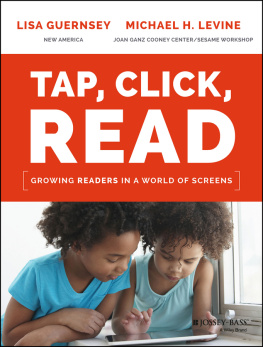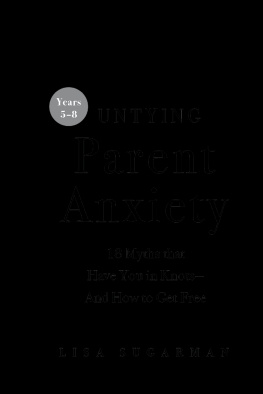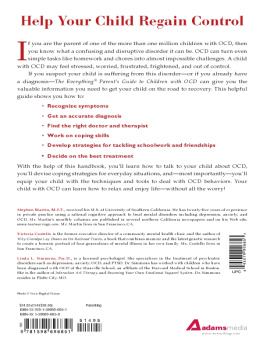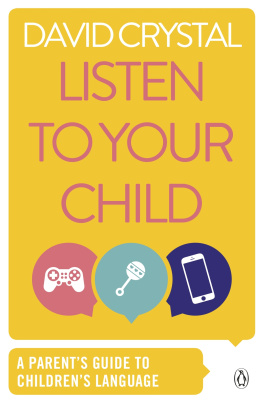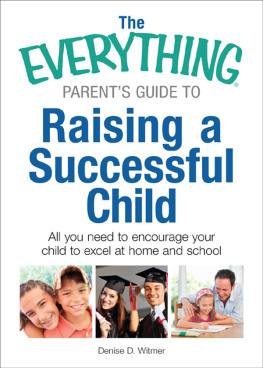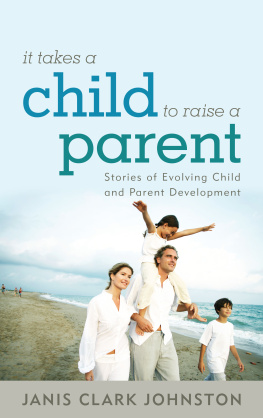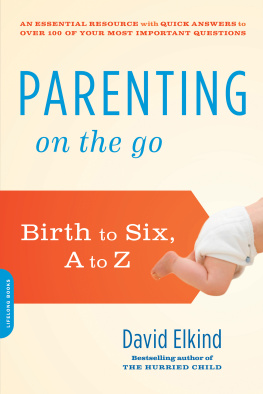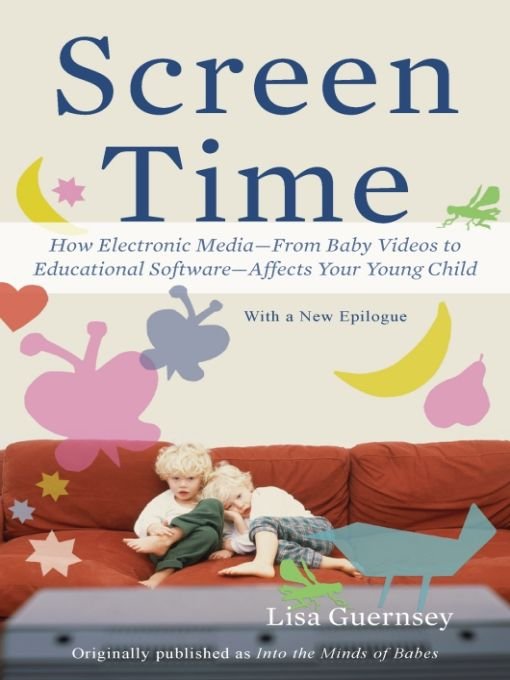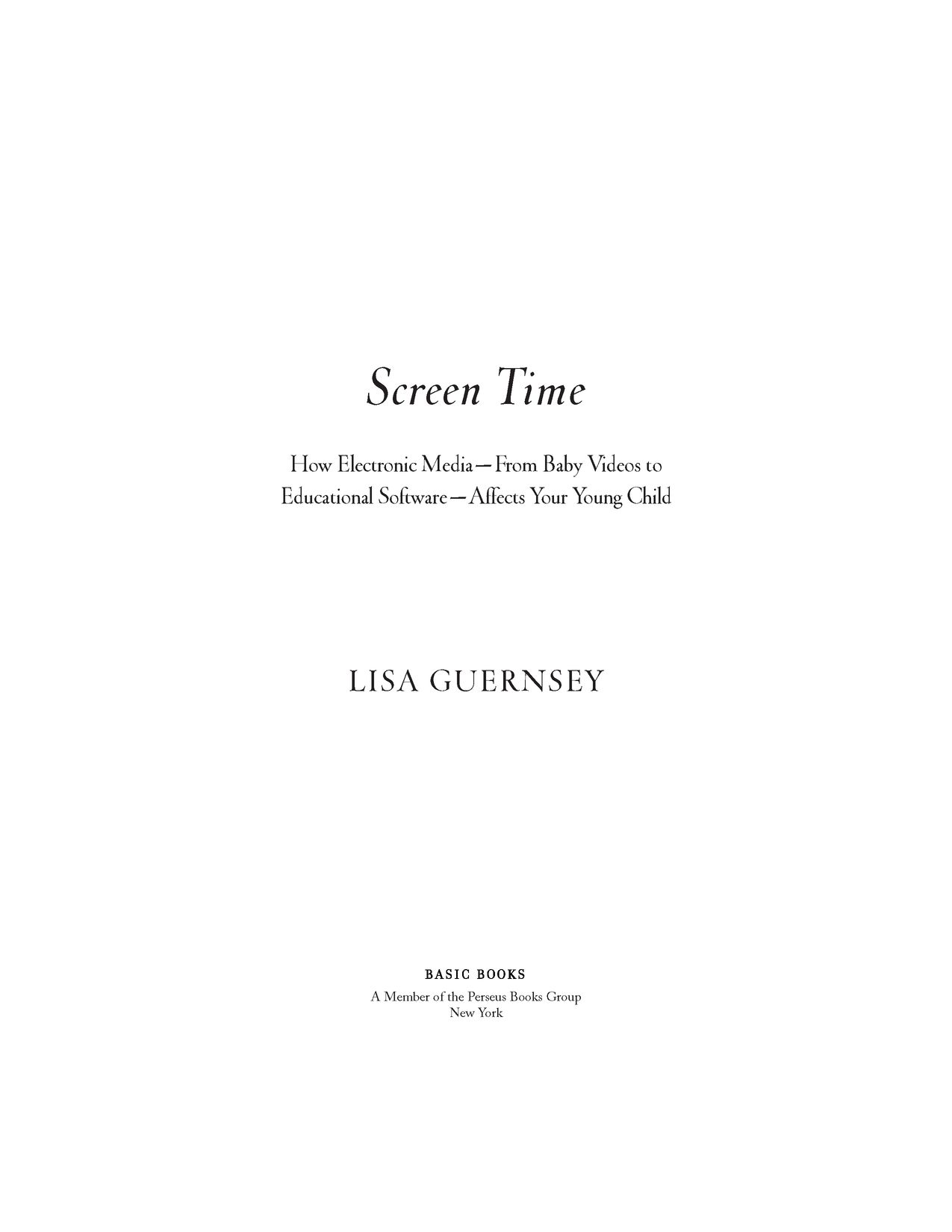Table of Contents
Praise for Screen Time
[Lisa Guernseys] approach is a gift to parents because she encourages them to decide what the best media choices are for their particular child.
Television Quarterly
A science journalist and mother of two, Guernsey manages to extricate straightforward information and guidelines from the morass of research, articles and debates on screen media and child brain development. Easily digestible chapters are smartly structured around 12 pervasive concerns of interviewees from all walks of life.
Publishers Weekly
Guernseys exploration of the world of electronic media and its positive and negative impact on young children is one we will all benefit from.
Robert Kesten, Executive Director,
Center for SCREEN-TIME Awareness
Written with passion and precision, humor and humility.... A calming and reassuring new resource for parents.
Claire Green,
President, Parents Choice Foundation
This journey into the best research on the impact of media on young children will serve as an essential guide to all those who care about kids.
Ellen Galinsky,
President, Families and Work Institute
To Janelle and Gillian
Foreword to the Paperback Edition
During the past fifteen years, baby media have exploded. Since the introduction of the Baby Einstein video in 1997, weve seen a variety of screen media directed to infants and toddlers, including a variety of television shows (Teletubbies and Classical Baby), entire cable channels such as Baby First TV, and computer software and applications for iPads and cell phones (such as Elmos Monster Maker App). From their introduction, such baby media made explicit claims about wanting to provide children with educational or informational programming in an entertaining presentational style that elicits the childrens attention and demonstrates to the parents that children are engaged and learning something, whether with colors, numbers, letters, or words. Also from their introduction, baby media have been controversial. In 1999 the American Academy of Pediatrics recommended no screen time for babies two and younger and a limit of two hours of screen time for older children, sending American parents into a quandary about the appropriateness of baby media. Much of this activity occurred without explicit research on whether babies are learning from such baby media and whether such media have either short-or long-term influences on childrens development.
Any examination of the research literature on childrens use of television in its early days (such as the 1950s studies reported in Television in the Lives of Children by Wilbur Schramm, Jack Lyle, and Edwin Parker) demonstrates that people were recognizing babies and toddlers as viewers of television from the moment TV sets were introduced into American homes (but without any hand-wringing over the fact). Furthermore, young children of the 1950s were asking for their favorite programs by the time they started talking around 2 years of age and were regular viewers of television by 2.8 years. But the number of programs expressly intended for very young children was relatively few: not until the 1960s and the arrival on national TV of both Fred Rogers Neighborhood and Sesame Street were programs being developed to educate the very youngest in the audience.
What did accelerate in the past fifteen years is both the number of baby media outlets and the amount of time children under six are spending with media. According to the 2011 Common Sense Media study of media use by children from birth to age eight, children under two years old spend on average nearly an hour a day (fifty-three minutes) with screen media (including TV, DVDs, computers or videogames) and nearly four out of ten babies under age two watched some screen media every day. And yet, until the past half dozen or so years, there was little research documenting the influence of screen media on these very young child viewers.
Indeed, the media market coupled with parental concerns about what is appropriate for young children and the admonitions of the 1999 AAP report led to studies of young childrens learning from baby videos as well as television shows babies watch. Can babies learn novel words from baby videos? At what age do very young children demonstrate attention to the formal production characteristics of videos such as camera movement? Can babies imitate behaviors they see on-screen?
It was into this mix of increasing baby media outlets and little research (but lots of opinion) that Lisa Guernseyboth a mother of young children and a journalistset out to make sense of what we do and dont know about media use by very young children. With this volume she fairly summarizes the growing body of research, which suggests that childrens learning from the baby videos currently in the marketplace has some limitations and depends on the viewing context and presence of adult guides, age appropriateness of the content, and the particular cognitive and social emotional development of the child. Lisa also explores and deciphers the research on educational media for preschoolers. Both academics and parents can find the literature reviewed here accessible and understandable. Indeed, Guernseys book was the first and best compilation of what academics know about babies and very young childrens use of and learning from screen media as well as a report on the various parental practices when parents do let their very young children watch screen media.
This book is noteworthy in that its first edition made public how much research has been done but also how much more we need to understand about both the short-term and long-term influences of screen media on childrens development. It helped spark the growth of this research literature, as is evident in this edition. And like the first edition, this edition provides parents with scientific evidence for their questions about the effects of baby media products.
Attitudes about screen media for young children are changing. Screen media are very much a part of American childrens lives, and parenting in this age of media technology requires an understanding of the influence of such media on our children. This book helps advance that understanding for all parents and concerned adults.
ELLEN WARTELLA
Northwestern University
December 2011
Preface, or the Three Cs: Content, Context and Your Child
My introduction to Baby Einstein came in a moment of panic. I was a new mother with a colicky 5-week-old baby, desperate for anything that might calm her. Try Baby Mozart, advised one of my closest friends, who had just emergedalivefrom six months of colic with her daughter. We call it baby crack.
On went the video, opening a window onto a terrain that I never knew existed before: the world of electronic media for the very young. Since then, as my daughter has grown and her younger sister arrived, companies have produced more and more multimedia programs for the stroller set. Videos promoting cognitive growth have been designed for babies as young as 2 months old. Television shows like Teletubbies, Boohbah and Oobi target toddlers. Videos for iPods, computer software, and games for portable devices, with screens no bigger than a box of raisins, are being made for 2- and 3-year-old kids.


